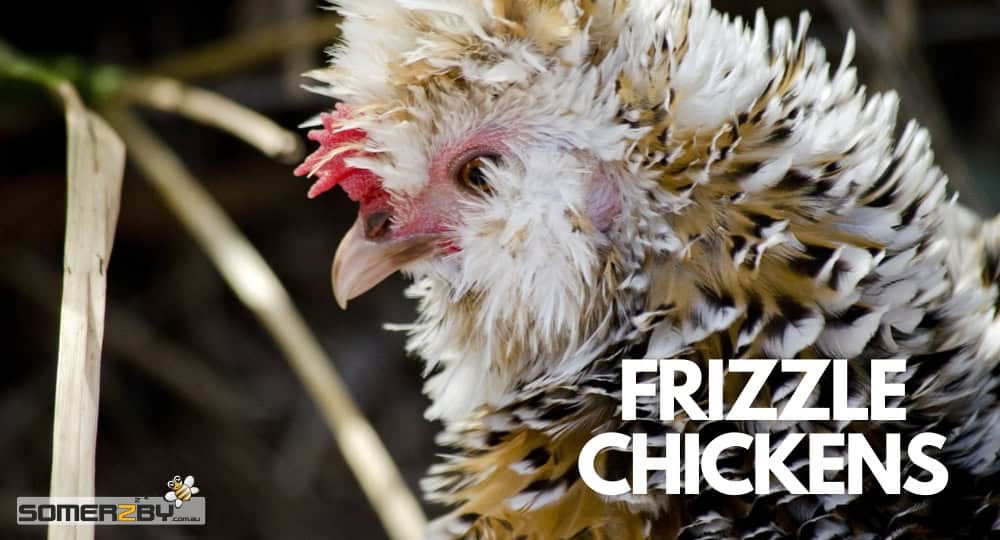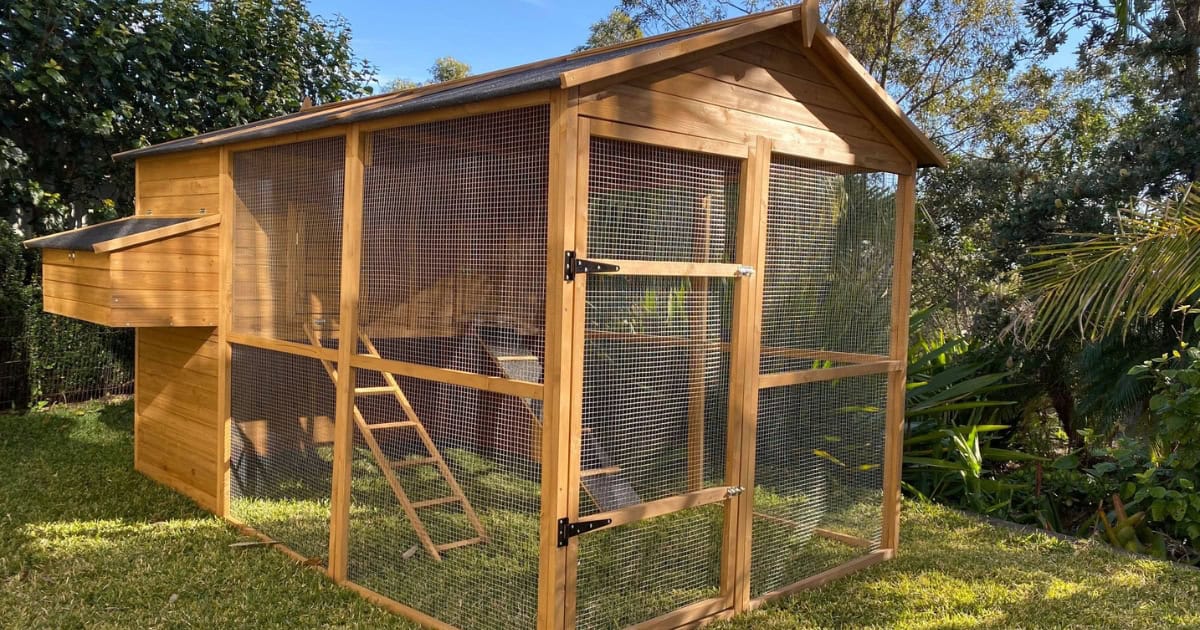Chickens, Info Guides
Frizzle Chickens – A Guide to the Fun Chicken Breed
Frizzle chickens are curly little bundles of fun!
They have unique curly plumage caused by the frizzle gene. Their appearance makes them an interesting addition to any backyard flock.
They are friendly and easy to handle, making them a great pet.
What is a Frizzle Chicken?
The Frizzle is a chicken breed that has distinctive curly feathers.
They are sometimes referred to as an exhibition breed or show chicken. This means they have an interesting appearance and do well in shows.
However, they are not very practical. They don’t handle temperature changes well and are poor egg layers.
What is Frizzling?
‘Frizzling’ is when a chicken’s feathers are curled. This gives them a fun and unique appearance.
The feather’s shaft will twist and curl upwards, away from the body. This is in comparison to standard chicken feathers which lay flat against their body.
Frizzling is caused by the incomplete dominant ‘frizzle gene’. It is believed the gene first originated by a mutation in the keratin gene.
Frizzle Breed Profile
Frizzle chickens are recognised as their own distinct breed in Australia, England, Ireland, France, Italy, German, Slovakia and the Czech Republic.
Their breed type is in the South Asia, Phillipines and Java chicken class.
In other countries (including the USA), frizzle is classified as a type of plumage but not its own particular breed.
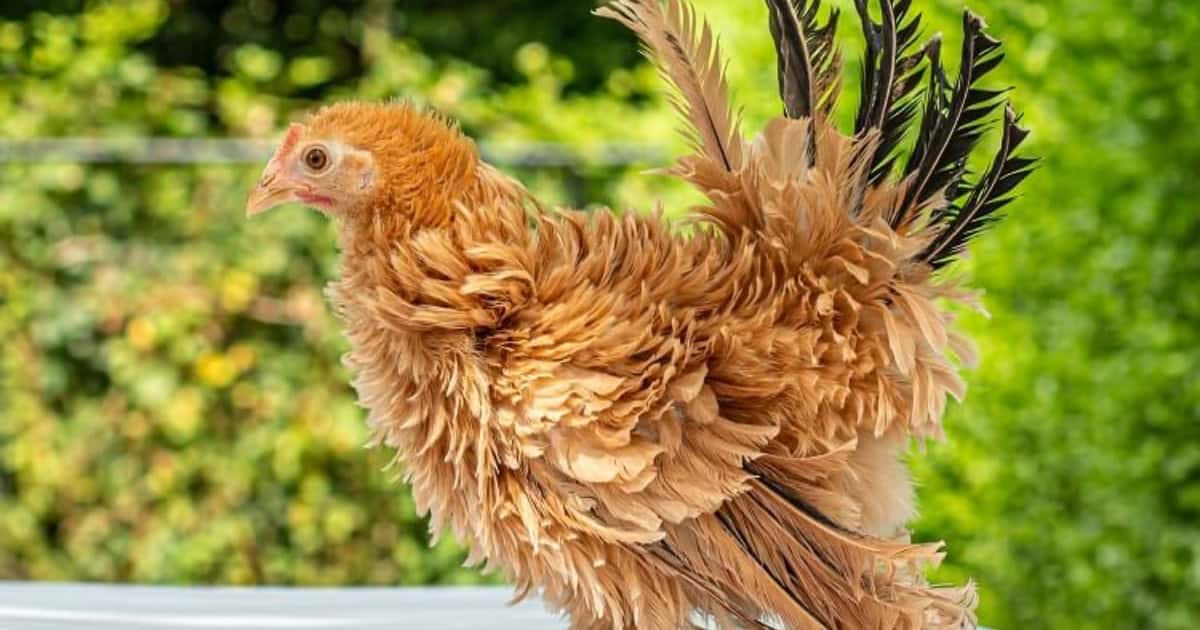
Frizzle Chickens Have a Distinctive Appearance
Frizzles have extremely distinctive curly feathers and their own recognised breeds in some countries including Australia and the UK
History of Frizzles
It is unknown when or where the Frizzle chicken breed originated.
It is believed they first originated in Asia, very possibly China or the East Indies.
They are not a new breed. The first recorded mention of them was from the 1600’s when they had already been taken to Western countries as breeding stock.
They were acknowledged by Charles Darwin in the 1800’s who referred to them as Caffie Fowl.
He noted there were a lot of them in India. However, he never visited India himself and it is unknown where he got this information from.
What Breeds Make a Frizzle Chicken?
It is unknown what breeds originally made the Frizzle chicken.
However, the frizzle gene most likely came about when a keratin gene accidentally mutated.
Other Frizzled Breeds
Some other chicken breeds can have the frizzle gene, meaning their plumage will also be curly. However, they are still classed as different breeds to the Frizzle chicken breed.
Certain breeds are more prone to frizzling. The most commonly found is the Frizzled Polish aka. the Polish Frizzle chicken.
Others include Frizzled Pekins, Frizzled Plymouth Rocks, Frizzled Japanese Bantams and Frizzled Buff Orpingtons.
These will often mistakenly get called or sold as a “Frizzle chicken” but this is incorrect as they are different breeds.
In Australia, the Sizzle breed can be found – they are a Frizzle chicken crossed with a Silkie chicken.
Frizzle Breed Standards
Breed standards are the guidelines set to describe the ideal characteristics of a chicken. They are used to judge chicken competitions.
In Australia, the Frizzle chicken breed standard is set by the Australian Poultry Standards (created by the Victorian Poultry Fanciers Association).
Chicken breed standards may vary slightly in European countries.
In the rest of the world, including North America, Frizzles are not recognised as a breed. However, they can still be entered into chicken exhibitions as other breeds.
Pure Frizzles will often be entered under the Frizzled Polish or Frizzled Pekin categories.
Feathers
A Frizzle’s most distinctive feature is their curly feathers. Some people have described them as a chicken feather duster!
Their curled plumage should look soft, not sharp. Some will appear neater while others will look messier.
Frizzled birds have fluffy feathers that are moderately long. They will curl away from the chicken’s body in an upwards motion, instead of lying flat against the body as a standard hen’s would.
Colours
Frizzle chickens come in many different colours and patterns.
These include black, black-red, brown, brown-red, red (like a Rhode Island Red), white, buff, blue, white Columbian, cuckoo, spangled (like an Old English Game), duckwing and pyle.
Appearance
Frizzle chickens have short, erect bodies with a full breast, big tail and long wings.
They have clean legs (which means they don’t have any feathers on them) with four toes on each foot. They have yellow feet with black shading allowed on black/blue Frizzles.
They have a small, single comb. Their combs, wattles and ear lobes are all bright red. Their eyes are also bright red.
A Frizzle’s beak is short, strong and yellow.
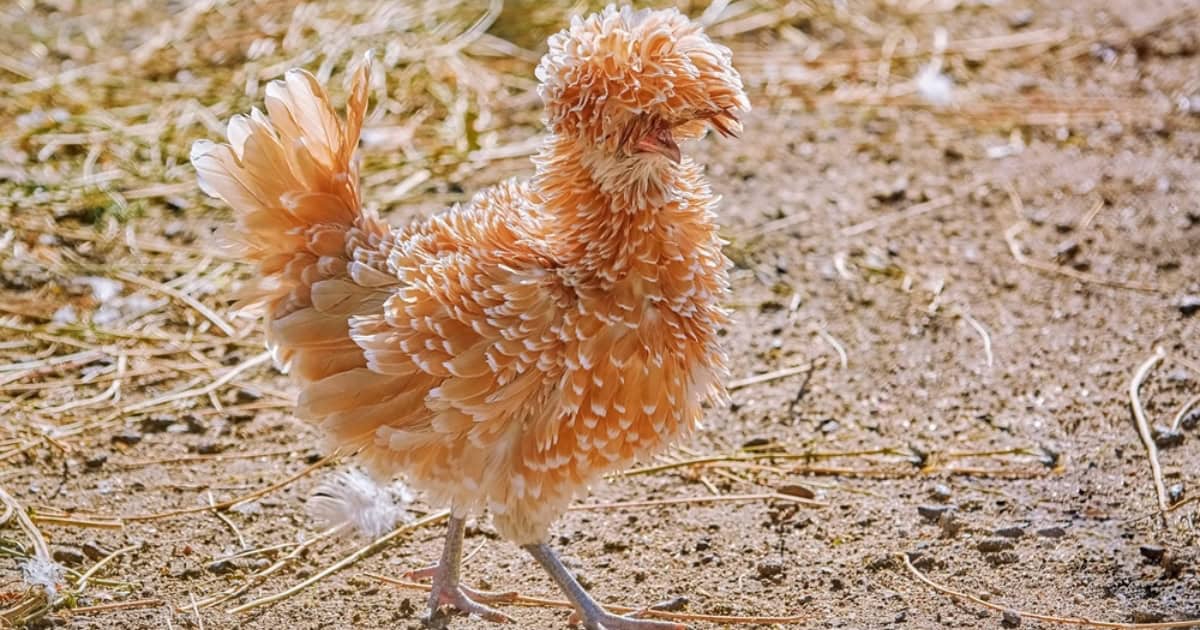
Curly Feathers
Frizzle chickens have curly feathers, short bodies, big tails and long wings.
Size
Frizzle chickens come in both a standard and bantam size.
Standard sized Frizzle hens weigh around 2.7kg and roosters weigh around 3.6kg.
Frizzle bantams are tiny! Hens weigh around 0.5kg and roosters weigh around 0.75kg.
Frizzle bantams are currently more popular in Australian than standard sized Frizzles. This is most likely due to how cute they are being so little and curly!
Eggs
Being a show bird, Frizzle chickens are not good layers compared to other chickens.
If you want a backyard chicken that will provide your whole family with lots of eggs, then a Frizzle probably isn’t for you.
Egg Color and Size
Frizzle chickens lay cream or tinted eggs. They are a medium sized egg.
Egg Laying
The number of eggs laid will vary between each bird. However, the average Frizzle chicken will lay between 120 and 150 eggs per year.
That is around 2 or 3 eggs per week per chicken.
They usually first start laying when they are 5 or 6 months old.
Frizzle Chickens as Pets
Frizzle chickens make wonderful pets. Frizzle owners are very passionate about their birds.
They are an interesting addition to your flock that will impress visitors and have everyone asking where you got them from.
Their curly, Frizzle feathers are poor insulators and struggle to keep their body at a constant temperature. This means they cannot handle the extreme cold or the rain.
They are quiet compared to other birds so won’t annoy your neighbours too much.
Temperament
Frizzle chickens are a very sweet and friendly bird. They aren’t too energetic and are fairly calm.
They are true lap chickens. They are gentle, easy to handle and enjoy some attention from their human owners.
Some owners even consider them ‘house chickens’ or a ‘house bird’ as they are well behaved enough to bring into your home on occasion.
They are suitable for families with children.
You can combine a Frizzle chicken with other breeds in your backyard flock. However, their docile nature means they are likely to be bullied by more assertive breeds.
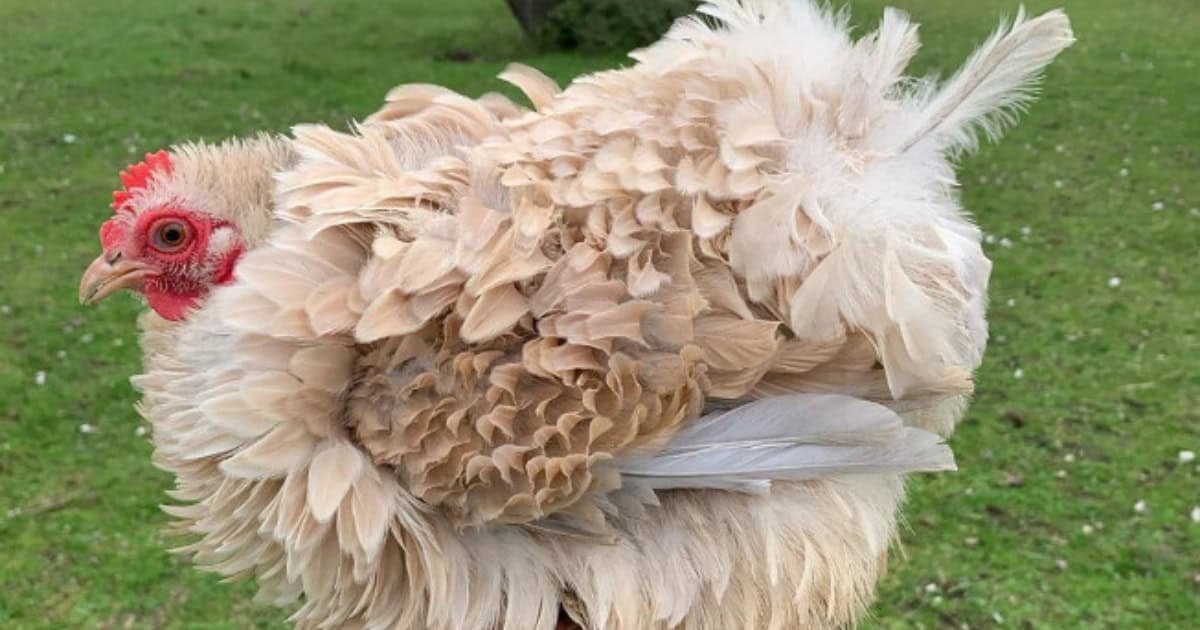
Gentle Temperament
They are gentle, easy to handle and enjoy some attention from their human owners
It is best to house them with other docile birds such Polish, Silkies or Wyandottes.
It is also a good idea to house them with birds of a similar size. So if you have bantam Frizzles, house them with other bantam breeds.
If you have standard Frizzles, house them with other standard sized chickens.
Keep an eye on your Frizzles to make sure they are not being pecked at or attacked.
If they are, you will probably have to separate them from your other chickens permanently.
Caring For Your Frizzle
Look after your Frizzle chickens by providing them with constant access to fresh water and feed them a high quality food daily.
Their curled feathers may sometimes grow in front of their eyes and limit their vision.
This can make them a bit jumpy. If they hear you enter their coop but can’t see you, they may panic!
You can trim their feathers around their eyes, but only a small bit at a time. Show birds are not allowed to have trimmed facial feathers for competitions.
If your bird seems unwell, always seek professional veterinary advice.
Chicken Coops
Like most backyard chicken breeds, Frizzles can handle confinement but are much happier if they are allowed to free range.
Most owners purchase a chicken coop for them to be housed in at night time then let them out into a larger yard area during the day to scratch around and roam happily.
Once the sun sets, your Frizzles will naturally wander back to their coop and you can lock them up safely overnight.
Because Frizzles handle the cold so poorly, you need need to choose a coop that is warm and has enclosed areas for them to escape the cold.
You will also need a chicken coop with a solid roof, so your birds can get out of the rain.
Frizzles cannot fly which is great for owners with low fences. They prefer coops with low perches as they won’t be able to fly up to reach higher ones.
Make sure your coop is predator proof and it will keep your flock safe.
What Size Coops do Frizzle Chickens Need?
The size you need will depend on how many chickens you are planning to keep.
You need to ensure there is enough room on the perches inside so all the chickens have a place to roost at night time together.
If you are planning for your flock to live inside the coop full time and they won’t be let out daily, you need to choose a much bigger coop with a lot of run space.
The general rule is to allow 1 square metre for each bird.
Somerzby Homestead Chicken Coop
The Homestead features easy clean and access with a new walk-in design and complete opening door suitable for up to 12 chickens
Nesting Box
Like most birds, Frizzle chickens will prefer to lay in a nesting box. It helps them to feel safe and protected while laying.
Nesting boxes are great for chicken owners too. You can always find their eggs easily without having to go searching your entire yard.
They also reduce the chance of eggs being stepped on and broken.
You will need one nesting space for every three hens. They won’t all lay at the same time and are happy to take turns sharing their nesting boxes.
Somerzby coops all come with nesting boxes mounted on the sides and with an opening lid.
This makes collecting eggs every day super simple. There is no need to go inside the coop to get them.
Breeding
Responsible bird breeders will only ever breed frizzle chickens with normal non-frizzled chickens.
Offspring only need one frizzled parent to also have the frizzling gene and curly feathers.
If you breed frizzle chickens together, the offspring are called frazzle chickens. They are extra curly but their feathers are very brittle.
They can be prone to feather breakage and baldness.
Frazzle chickens are also commonly born with heart problems and live shorter lives.
Frizzle hens will sometimes go broody and are therefore suitable for hatching fertile eggs. If you allow them to raise the chicks, they make very attentive mothers.
Rooster vs Hen
After 4-8 weeks, Frizzle hens and roosters will have some obvious physical differences to help you tell them apart.
Roosters will grow larger and have longer tail feathers. Their combs and wattles will get redder much earlier than a hen’s will.
Roosters will also begin to crow when they are anywhere between 1 and 16 weeks old.
Most backyard Frizzle owners choose to only keep hens in their flock. This is partly because hens are able to lay eggs.
And partly because hens make better pets. They are much friendlier, easier to handle and happy to spend time with humans.
Frizzle roosters are prone to becoming aggressive. An aggressive rooster is harder to care for as you cannot approach it or pick it up if you need to.
They may become violent and attack either you or your hens, causing serious damage with the sharp spurs on their feet.
In comparison to other chicken breeds, Frizzle roosters aren’t as hostile. Some even end up being friendly. But it can be very hard to predict.
Some people say hens will be happier if they have at least one rooster in their flock.
If you are thinking about getting a rooster, make sure you are prepared to handle it if it turns out to be aggressive.
We recommend contacting your local council to find out about their rules and restrictions on rooster ownership, especially if you live in a suburban area.
How Do You Tell If A Chick Is A Frizzle?
Within the first 14 days, you will be able to tell if a chick has the frizzling gene. Its feathers will start to stick up and grow outwards, away from its body. This makes them look extra cute and fluffy!
On regular chicks, feather will lay flat against their body.
When you hatch chicks, you would usually leave them in the brooder for six weeks. However, Frizzle chicks can be slower to feather out and may need to be kept warm for longer.
Feathering out is when a chick loses its original fuzzy coat and grows its first real feathers.
Buying
Frizzle chickens are not very common in Australia. This means they are harder to find and often more expensive than most breeds.
You can buy Frizzle chickens from poultry breeders or farm supply stores. Some sellers are able to transport the birds to you for an extra fee.
Most people will buy Frizzles as point of lay chickens. This means they are at the age when they are about to start laying (which is around 5-6 months old).
They will cost around $40. In comparison, more popular breeds will typically sell for around $25.
Day old Frizzle chicks will be cheaper at around $15 per chick. You will need a brooder to keep them constantly warm.
You will also need to keep them separated from adult birds until they are big enough to defend themselves.
Some sellers are able to sex day old chicks so you know you are getting a hen. However, not every seller can so there is a risk that when you buy day old chicks you may get some unwanted roosters.
The cheapest way to buy Frizzles is as fertile eggs. They will usually cost $24 for a dozen.
To hatch eggs, you will need an incubator. This can take a lot of time and effort. It isn’t guaranteed that all the eggs will hatch either!
Hatching Frizzle eggs is a fun activity to do with children to teach them about where chickens come from.




